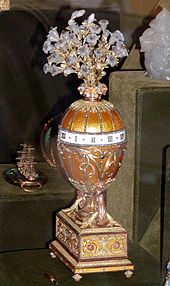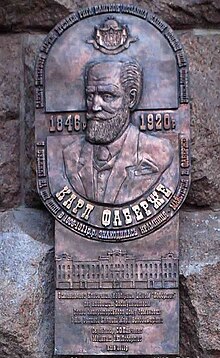Quick Facts
Biography
Peter Carl Fabergé, also known as Karl Gustavovich Fabergé (Russian: Карл Гу́ставович Фаберже́, Karl Gustavovich Faberzhe; 30 May 1846 – 24 September 1920), was a Russian jeweller best known for the famous Fabergé eggs made in the style of genuine Easter eggs, but using precious metals and gemstones rather than more mundane materials.
Early life

He was born in Saint Petersburg, Russia, to the Baltic German jeweller Gustav Fabergé and his Danish wife Charlotte Jungstedt. Gustav Fabergé's paternal ancestors were Huguenots, originally from La Bouteille, Picardy, who fled from France after the revocation of the Edict of Nantes, first to Germany near Berlin, then in 1800 to the Pernau (today Pärnu) Baltic province of Livonia, then part of Russia.
Initially educated in Saint Petersburg, Russia, in 1860 Gustav Fabergé, together with his wife and children, retired to Dresden, leaving the business at House of Fabergé in Saint Petersburg in the hands of capable and trusted Peter Carl; he possibly undertook a course at the Dresden Arts and Crafts School. Two years later Agathon, the Fabergés' second son, was born.
In 1864, Peter Carl embarked upon a Grand Tour of Europe. He received tuition from respected goldsmiths in Germany, France and England, attended a course at Schloss's Commercial College in Paris, and viewed the objects in the galleries of Europe's leading museums.
His travel and study continued until 1872, when at the age of 26 he returned to St. Petersburg and married Augusta Julia Jacobs. For the following 10 years, his father's trusted workmaster Hiskias Pendin acted as his mentor and tutor. The company was also involved with cataloguing, repairing, and restoring objects in the Hermitage during the 1870s. In 1881 the business moved to larger street-level premises at 16/18 Bolshaya Morskaya.
Taking over the family business

Upon the death of Hiskias Pendin in 1882, Carl Fabergé took sole responsibility for running the company. Carl was awarded the title Master Goldsmith, which permitted him to use his own hallmark in addition to that of the firm. Carl Fabergé's reputation was so high that the normal three-day examination was waived.. For several years, Carl Faberge's main assistant in the designing of jewellery was his younger brother, Agathon Faberge (1862-1895), who had also trained in Dresden.
Carl and Agathon were a sensation at the Pan-Russian Exhibition held in Moscow in 1882. Carl was awarded a gold medal and the St. Stanisias Medal. One of the Fabergé pieces displayed was a replica of a 4th-century BC gold bangle from the Scythian Treasure in the Hermitage. The Tsar, Alexander III, "Emperor and Autocrat of all the Russians", declared that he could not distinguish the Fabergé's work from the original and ordered that objects by the House of Fabergé should be displayed in the Hermitage as examples of superb contemporary Russian craftsmanship. The House of Fabergé with its range of jewels was now within the focus of Russia's Imperial Court.
When Peter Carl took over the House, there was a move from producing jewellery in the then-fashionable French 18th century style to becoming artist-jewellers.
Fabergé's production of the very first so-called Fabergé egg, the Hen Egg, given as a gift from the Tsar to his wife Maria Fyodorovna on Orthodox Easter (24 March) of 1885 so delighted her that on 1 May the Emperor assigned Fabergé the title Goldsmith by special appointment to the Imperial Crown of that year. This meant that Fabergé now had full personal access to the important Hermitage Collection, where he was able to study and find inspiration for developing his unique personal style. Influenced by the jewelled bouquets created by the eighteenth century goldsmiths Jean-Jacques Duval and Jérémie Pauzié, Fabergé re-worked their ideas combining them with his accurate observations and his fascination for Japanese art. This resulted in a revival of the lost art of enameling and a focus on the setting of every single gemstone in a piece to its best visual advantage. Indeed, it was not unusual for Agathon to make ten or more wax models so that all possibilities could be exhausted before deciding on a final design. Shortly after Agathon joined the firm, the House introduced objects deluxe: gold bejewelled items embellished with enamel ranging from electric bell pushes to cigarette cases and including objects de fantaisie.
Easter eggs

In light of the Empress' response to receiving one of Fabergé's eggs on Easter, the Tsar soon commissioned the company to make an Easter egg as a gift for her every year thereafter. The Tsar placed an order for another egg the following year. Beginning in 1887, the Tsar apparently gave Carl Fabergé complete freedom with regard to egg designs, which then became more and more elaborate. According to Fabergé Family tradition, not even the Tsar knew what form they would take— the only stipulation was that each one should be unique and each should contain a surprise. Upon the death of Alexander III, his son, the next Tsar, Nicholas II, followed this tradition and expanded it by requesting that there be two eggs each year, one for his mother (who was eventually given a total of 30 such eggs) and one for his wife, Alexandra (who received another 20). These Easter gift eggs are today distinguished from the other jeweled eggs Fabergé ended up producing by their designation as "Imperial Easter eggs" or "Tsar Imperial Easter eggs". The tradition continued until the October Revolution when the entire Romanov dynasty was executed and the eggs and many other treasures were confiscated by the interim government. The two final eggs were never delivered nor paid for.
Although today the House of Fabergé is famed for its Imperial Easter eggs, it made many more objects ranging from silver tableware to fine jewelry which were also of exceptional quality and beauty, and until its departure from Russia during the revolution, Fabergé's company became the largest jewelry business in the country. In addition to its Saint Petersburg headquarters, it had branches in Moscow, Odessa, Kiev and London. It produced some 150,000 to 200,000 objects from 1882 until 1917.
In 1900, Fabergé's work represented Russia at the 1900 World's Fair in Paris. As Carl Fabergé was a member of the jury, the House of Fabergé exhibited hors concours (without competing). Nevertheless, the House was awarded a gold medal and the city's jewelers recognized Carl Fabergé as a maître. Additionally, France recognized Carl Fabergé with one of the most prestigious of French awards, appointing him a knight of the Legion of Honour. Two of Carl's sons and his head workmaster were also honored. Commercially, the exposition was a great success and the firm acquired a great many orders and clients.


Stock, Russian Revolution and nationalisation
In 1916, the House of Fabergé became a joint-stock company with a capital of 3-million rubles.
The following year upon the outbreak of the October Revolution, the business was taken over by a 'Committee of the Employees of the Company K Fabergé. In 1918 The House of Fabergé was nationalised by the Bolsheviks. In early October the stock was confiscated. The House of Fabergé was no more.
After the nationalisation of the business, Carl Fabergé left St. Petersburg on the last diplomatic train for Riga. In mid-November, the Revolution having reached Latvia, he fled to Germany and first settled in Bad Homburg and then in Wiesbaden. Eugène, the Fabergés' eldest, travelled with his mother in darkness by sleigh and on foot through snow-covered woods and reached Finland in December 1918. During June 1920, Eugène reached Wiesbaden and accompanied his father to Switzerland where other members of the family had taken refuge at the Bellevue Hotel in Pully, near Lausanne.
Peter Carl Fabergé never recovered from the shock of the Russian Revolution. He died in Switzerland on September 24, 1920. His family believed he died of a broken heart. His wife, Augusta, died in 1925. The two were reunited in 1929 when Eugène Fabergé took his father's ashes from Lausanne and buried them in his mother's grave at the Cimetière du Grand Jas in Cannes, France.
Fabergé had four sons: Eugène (1874–1960), Agathon (1876–1951), Alexander (1877–1952) and Nicholas (1884–1939). Descendants of Peter Carl Fabergé live in mainland Europe, Scandinavia and South America.
Personal life
Henry Bainbridge, a manager of the London branch of the House of Fabergé, recorded recollections of his meetings with his employer in both his autobiography and the book he wrote about Fabergé. We are also given an insight into the man from the recollections of François Birbaum, Fabergé's senior master craftsman from 1893 until the House's demise.
From Bainbridge we know that while punctilious with his dress, Fabergé "rarely if ever wore black but favoured well-cut tweeds". He added "There was an air of the country gentleman about him, at times he reminded one of an immaculate gamekeeper with large pockets." He was a very focused individual with no wasted actions or speech. He did not like small talk. On one occasion during dinner Bainbridge, feeling out of the conversation said, I see Lord Swaythingly is dead. Fabergé asked who he was and upon being told responded cuttingly, "And what can I do with a dead banker?"
When taking orders from customers he was always in a hurry and would soon forget the fine detail. He would then interrogate the staff so as to find any who had been standing near him and may have overheard. His great-granddaughter Tatiana Fabergé notes that he usually had a knotted handkerchief in his breast pocket.
When Carl noticed an unsuccessfully wrought item, he would call for his senior master craftsman and make endless derisory and ironic remarks. On occasions when Birbaum realized Fabergé was the designer, he would show him his sketch. Fabergé would then smile guiltily and say, "Since there is nobody to scold me, I have had to do it myself".
From Birbaum we also know that Carl was famous for his wit and was quite merciless to fops, whom he hated. A certain prince who fell into this category boasted to Fabergé about his latest honour from the Tsar, adding that he had no idea as to why the award was made. The prince expected the jeweler to shower him with congratulations. Instead, Fabergé simply replied, "Indeed, your Highness, I too have no idea what for".
Carl never traveled with luggage—he bought all his requisites at his destination. On one occasion, when he arrived at the Negresco Hotel in Nice the doorman barred him from entering because of the amount of luggage he carried. Thankfully one of the grand dukes who was in residence called out a greeting and Carl Fabergé was promptly ushered apologetically into the establishment.
Bainbridge concludes, "Taking him all in all, Fabergé came as near to a complete understanding of human nature as it is possible for a man to come, with one word only inscribed on his banner, and that word – tolerance. There is no doubt whatsoever that this consideration for the worth of others was the foundation for his success."
In memory of Carl Fabergé

- Ukraine, Kiev, Khreschatyk Street, Building 15 (25) - Commemorative plaque.
